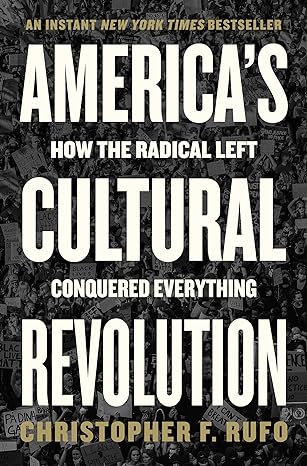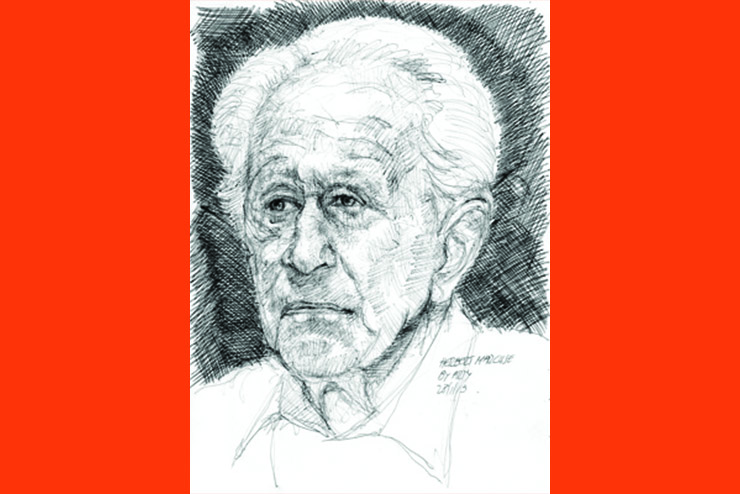
America’s Cultural Revolution: How the Radical Left Conquered Everything
by Christopher F. Rufo
Broadside Books
352 pp., $32.00
America is a land of revolutions and awakenings; revolutions in its political order and awakenings in the souls of its people are woven into its history. Another revolution has taken place within America in the last few years, and a new awakening among the country’s ressentiment-ridden disaffected classes.
Christopher Rufo brings us his first book on the origins of this recent turmoil, endeavoring to explain the what, who, why, and how of a world turned upside down. Rufo excavates several unpleasant and destructive left-wing thought streams that are eroding the social order on which we all depend. His prescriptions for action are convincing, though it is less certain whether his diagnosis is accurate.
Rufo’s approach is both biographical and intellectual. He profiles the four figures he sees as progenitors of America’s ideological capture: the German-American political theorist Herbert Marcuse, the political activist Angela Davis, the Brazilian educator Paolo Freire, and the lawyer and civil rights activist Derrick Bell. The four figures have sections devoted to them, beginning with a biographical portrait, followed by chapters explaining the substance of their theories, their impact on their respective cultures, and their role they play in today’s America.
Rufo outlines the influence of each figure while quoting from their work. Marcuse created Critical Theory to undermine the very foundations of American society and culture, which he saw as having anesthetized the revolutionary potential of the working class through “an ever-more-comfortable life.”
Angela Davis then applied Marcuse’s theory through identity politics, fomenting a revolutionary alliance between the marginalized black underclass and upper-class white radicals. This was the kind of high-low coalition against the bourgeois middle described by French political theorist Bertrand de Jouvenel.
Friere constructed a pedagogy to instill “revolutionary consciousness” in children, inverting the purpose of education from an introduction into received morals and traditions to a ritual indoctrination in activist perspectives that depicted society as irredeemably corrupt.
Finally, Bell built the edifice of critical race theory that equated all racial disparities with racial discrimination. This was a solvent meant to dissolve the foundation of America’s legal system and to weaponize it against white Americans.
This is a revolution from above, fomented by leftists in the halls of academia and government in a long march through the institutions. Capturing them from within, they have implemented a revolutionary ideology that has “gnawed, chewed, smashed, and disintegrated the entire system of values that came before it,” Rufo writes.
After spending time with these individuals through Rufo’s book, one finds oneself repulsed. Their lives, characters, and conduct are as repugnant as their ideologies. Each individual comes across as morally depraved and spiritually degenerate. Marcuse admittedly starts as the most sympathetic—a bourgeois European intellectual of a culturally conservative disposition who criticized the rise of America’s postwar managerial elite. Marcuse’s desire for a revolution against those forces ended with his support for the reprobates of the cultural left and their political violence during 1968. As for Davis, though she was acquitted of involvement in a violent 1970 courtroom hostage situation, she bears some responsibility for the deaths that occurred. She was a Communist true believer who supported the gulag system and who argued for violent racial revolution in the United States.
Rufo goes beyond the theoretical to describe and analyze the implementation of each segment of the revolutionary worldview in the power structures and institutions of modern American life: academia, the media, the nonprofit sector, law, medicine, politics, the administrative state, and the world of corporate capitalism. He connects the left’s abstract theories with their operation throughout the book.
The book’s taxonomy works well, with each section flowing into the other in an interlocking narrative showing how each figure and theory influenced and produced the next. There’s an academic seriousness to Rufo’s tract that is rare in America’s right-wing publishing space, where many authors are broadcast media talking heads. The tirades produced by these usually poorly educated publicists inveigh against Marxism and the Frankfurt School for causing all of America’s problems. Rufo’s polemical style conveys that he is far from impartial, but he takes his subject matter seriously and treats it with the requisite rigor.
After analyzing the ideology of the leftist revolution, Rufo provides his solution: counterrevolution. This would be waged politically through the organs of the state and by using the levers of executive, legislative, and judicial power to reverse the conquest of America’s institutions. Rufo’s belief that the right may be able to conduct its own “march through the institutions” is based on his hope that average Americans “will be able to feel the truth intuitively” and that “this realization cannot be stopped.” Ironically, by claiming such historical inevitability and reliability on the part of regular people, Rufo is adopting a Marxist way of looking at history; it is to insist that a popular realization of wokeness’s inner, insuperable contradictions will inevitably occur, in the same way that the Marxists insisted (wrongly) that capitalism would collapse from its contradictions.
Rufo does not hide his own ideology, which is partly influenced by his fellowships at the Heritage Institute and the Claremont Institute. The result is a capable deconstruction of America’s left-wing ideological enemies through a West Coast Straussian lens. Thus, Rufo proposes what he sees as a positive vision that recovers “natural right, the Constitution, and the dignity of the individual.” This is to be achieved, he writes, by restoring “the revolution of 1776” and its ideals of “family, faith, work, community, country” and core values of “excellence over diversity, equality over equity, dignity over inclusion, order over chaos.” This is the West Coast Straussian vision of the Good based on universal rights posited at least intermittently by America’s founders.
Yet this leads me to my problems with Rufo’s diagnosis. He still falls into the trap that so many American conservatives do in arguing that leftism is driven by a form of Marxism imported from outside America’s shores. In this view, leftism is an alien ideology parasitic on America’s political and cultural tradition rather than a dire consequence of the liberalism inherent within the American political system itself. It is the fetishization of equality that may have contributed to the quandary in which Americans and other Westerners now find themselves.
Thus, Rufo makes the same arguments against “cultural Marxism” and the malign influence of the German Frankfurt School others have made, even if he is careful not to paint with as broad a brush as Mark Levin does in American Marxism (2021).
Yet, again and again, Rufo admits in his four profiles that the theorists in question weren’t orthodox Marxists and didn’t theorize, propose, or practice Marxism traditionally understood. Rather, the four leftists fundamentally innovated from within America’s liberal democratic system and innovated well beyond what Marxism originally theorized. How many caveats can Rufo make before he can admit that maybe the “woke” ideology isn’t Marxism, and these ideologues weren’t Marxists?
In a recent interview, Rufo stated that because the corporate oligarchs are perfectly happy to impose a woke worldview through their corporate structures, one could describe it as Marxism without Marx. Oh? In that case, maybe we can have Christianity without Jesus Christ! Narratives of oppressor and oppressed are foundational for left-wing politics. They are not unique to Marxism and go at least as far back as the French Revolution.
America faces not an importation of Marxism into an otherwise pristine political and cultural ecology but a political environment of continued revolution expanding on the one that occurred in 1776. Unfortunately, Rufo does not engage with James Burnham’s theory of the managerial revolution in depth, which explains the growth of the American elite administrative class in the early-to-mid-20th century and carries more explanatory power than blaming some German immigrants from Frankfurt.
Rather than cultural Marxism, the managerial elite adopted postwar consensus liberalism, which evolved into neoliberalism and neoconservatism during the 1970s and 8os. In the aftermath of the 2008 financial crisis and the digital revolution, this class adopted “wokeness.” Burnham and other theorists of the elite political class understood that ruling classes are not driven by ideology but adopt whatever values could be made to legitimize their rule. They also operate within the already established moral and cultural parameters of the societies they come to dominate.
Indeed, as British sociologist Frank Furedi shows in his 2021 book, 100 Years of Identity Crisis, America’s political culture was already moving left long before the figures Rufo describes came on the scene. The training of children to reject traditional morals, along with a therapeutic state and transnational corporate and political managerial structures, was already well advanced before Marcuse arrived.
What we have in “wokeness” is a synthesis of an America-specific emancipatory liberalism and Social Gospel-inflected progressivism, turbocharged and radicalized through the institutions that hosted the figures Rufo analyzes. The ideology itself isn’t Marxist. Marcuse, Davis, Friere, and Bell didn’t start the fire that threatens to consume America—it was always burning.



Leave a Reply